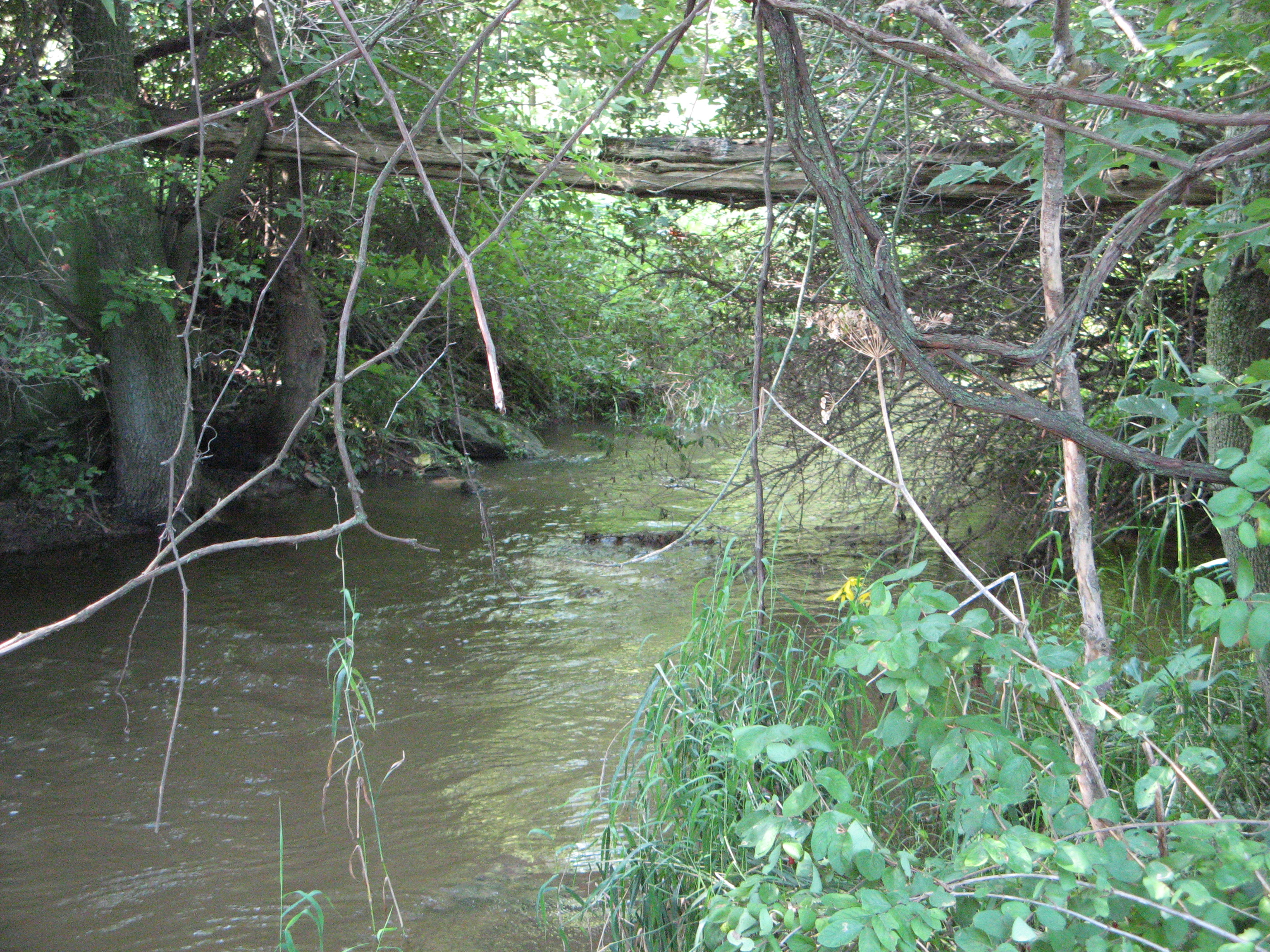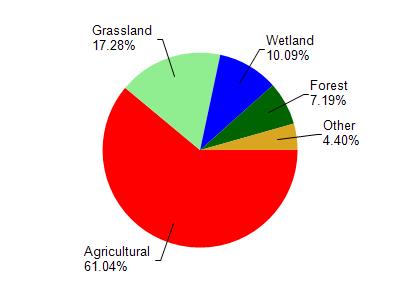
3 Miles
0 - 3
Cool-Cold Mainstem, Cool-Cold Headwater
2016
Good
Kewaunee
Yes
No
No
Fish and Aquatic Life
Overview
Scarboro Creek is a clear stream that flows 15 miles from its headwaters in Brown County to its confluence with the Kewaunee River. The stream gradient is about 10 feet per mile until the creek flows into the Kewaunee Valley, where the gradient increases to 30 feet per mile.
The lower four miles are Class II brown trout waters and this reach is stocked annually. This segment also supports brook trout where the gradient is steepest. There is some carryover of these trout, and trout eggs have been observed on the bottom. The three miles above Valley Road supports a fish community in transition, with some warmwater species present but forage species dominant. Above Hill Road, the stream narrows and supports mainly forage fishes. Most of the stream in Brown County is intermittent. In the lower portions of Scarboro Creek, public access is limited to one road crossing. Access via road crossings increases above Valley Road.
Water quality data indicate the trout waters on Scarboro Creek are degraded, but that the stream has excellent potential for improvement. Macroinvertebrates collected in 1989 represented species typically associated with fair to fairly-poor water quality. Sedimentation is likely affecting trout reproduction. Flow and temperature conditions are excellent. Dissolved oxygen conditions are probably degraded at times, as indicated by the aquatic insects in the stream. Nutrients and organic matter from nonpoint sources of water pollution are associated with this problem. In addition, turbidity could be affecting the fish. Overall water quality in this portion of the creek is fair to good. Data indicate water quality has been degraded in the three-mile segment between Valley and Hill Roads. Overall water quality is fair, but dissolved oxygen concentrations are often below the standard established for the protection of warmwater fishes. Problems worsen in a 2.5 mile long stream segment above Hill Road. Water quality here is poor and dissolved oxygen depression more marked. Some of these threats to fish may be related to natural flow and temperature conditions, but some is undoubtedly due to nutrient enrichment and decomposition of organic materials from agricultural sources. Turbidity is also a concern in these upper sections of Scarboro Creek, however, sedimentation does not appear to be much of a problem.
From: Willman, Guy and Mike Toneys. 2001. The State of the Lakeshore Basin. Wisconsin Department of Natural Resources, Madison, WI.
Date 2001
Author Michael Toneys
General Condition
Scarboro Creek was assessed during the 2018 listing cycle; new total phosphorus and biological (fish Index of Biotic Integrity (IBI) scores) sample data were clearly below the 2018 WisCALM listing thresholds for the Fish and Aquatic Life use. This water was meeting this designated use and was not considered impaired.
Date 2017
Author Ashley Beranek
Condition
Wisconsin has over 84,000 miles of streams, 15,000 lakes and milllions of acres of wetlands. Assessing the condition of this vast amount of water is challenging. The state's water monitoring program uses a media-based, cross-program approach to analyze water condition. An updated monitoring strategy (2015-2020) is now available. Compliance with Clean Water Act fishable, swimmable standards are located in the Executive Summary of Water Condition in 2018. See also the 'monitoring and projects' tab.
Reports
Recommendations
Monitor Aquatic Biology
Conduct biological (mIBI or fIBI) monitoring on Scarboro Creek, WBIC: 91000, AU:10175
Navigability Determination
SE SE S12 T23N R22E; ; Mapped in Brown County also
Management Goals
Wisconsin's Water Quality Standards provide qualitative and quantitative goals for waters that are protective of Fishable, Swimmable conditions [Learn more]. Waters that do not meet water quality standards are considered impaired and restoration actions are planned and carried out until the water is once again fishable and swimmable
Management goals can include creation or implementation of a Total Maximum Daily Load analysis, a Nine Key Element Plan, or other restoration work, education and outreach and more. If specific recommendations exist for this water, they will be displayed below online.
Monitoring
Monitoring the condition of a river, stream, or lake includes gathering physical, chemical, biological, and habitat data. Comprehensive studies often gather all these parameters in great detail, while lighter assessment events will involve sampling physical, chemical and biological data such as macroinvertebrates. Aquatic macroinvertebrates and fish communities integrate watershed or catchment condition, providing great insight into overall ecosystem health. Chemical and habitat parameters tell researchers more about human induced problems including contaminated runoff, point source dischargers, or habitat issues that foster or limit the potential of aquatic communities to thrive in a given area. Wisconsin's Water Monitoring Strategy was recenty updated.
Grants and Management Projects
Monitoring Projects
| WBIC | Official Waterbody Name | Station ID | Station Name | Earliest Fieldwork Date | Latest Fieldwork Date | View Station | View Data |
|---|
| 91000 | Scarboro Creek | 313168 | Scarboro Creek at Cth A | 10/7/1991 | 10/25/2016 | Map | Data |
| 91000 | Scarboro Creek | 10020721 | Scarboro Creek-Riffle Area Under Bridge Off Co. T. A | | | Map | Data |
| 91000 | Scarboro Creek | 10007986 | Scarboro Creek #1 (S. Of Cth A) | 10/26/1978 | 1/1/2015 | Map | Data |
|

Watershed Characteristics
Scarboro Creek is located in the Kewaunee River watershed which is 142.12 mi². Land use in the watershed is primarily agricultural (61.10%), grassland (17.30%) and a mix of wetland (10.10%) and other uses (11.60%). This watershed has 292.03 stream miles, 540.90 lake acres and 7,312.87 wetland acres.
Nonpoint Source Characteristics
This watershed is ranked High for runoff impacts on streams, Not Ranked for runoff impacts on lakes and High for runoff impacts on groundwater and therefore has an overall rank of High. This value can be used in ranking the watershed or individual waterbodies for grant funding under state and county programs.However, all waters are affected by diffuse pollutant sources regardless of initial water quality. Applications for specific runoff projects under state or county grant programs may be pursued. For more information, go to surface water program grants.
Scarboro Creek is considered a Cool-Cold Mainstem, Cool-Cold Headwater under the state's Natural Community Determinations.
Natural communities (stream and lake natural communities) represent model results and DNR staff valiation processes that confirm or update predicted conditions based on flow and temperature modeling from historic and current landscape features and related variables. Predicated flow and temperatures for waters are associated predicated fish assemblages (communities). Biologists evaluate the model results against current survey data to determine if the modeled results are corect and whether biological indicators show water quaity degradation. This analysis is a core component of the state's resource management framework. Wisconsin's Riverine Natural Communities.
Cool (Cold-Transition) Mainstem streams are moderate-to-large but still wadeable perennial streams with cold to cool summer temperatures. Coldwater fishes are common to uncommon, transitional fishes are abundant to common, and warm water fishes are uncommon to absent. Headwater species are common to absent,
mainstem species are abundant to common, and river species are common to absent.
Cool (Cold-Transition) Headwaters are small, usually perennial streams with cold to cool summer temperatures. Coldwater fishes are common to uncommon (<10 per 100 m), transitional fishes are abundant to common, and warm water fishes are uncommon to absent. Headwater species are abundant to common, mainstem species are common to absent, and river species are absent.